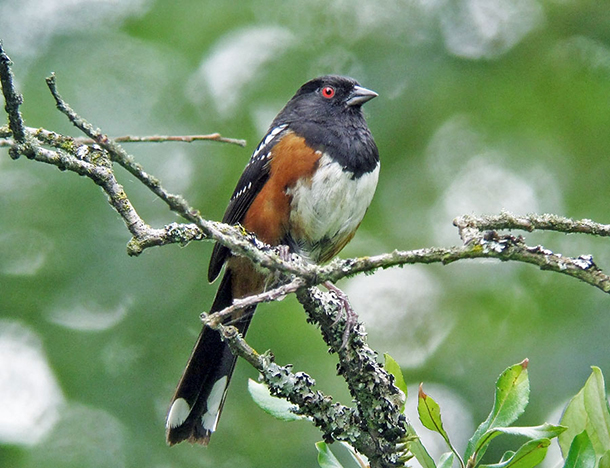BirdNote: What's in a Name?
Air Date: Week of February 10, 2017
.jpg)
Northern Flicker, which used to be known as the Red-shafted Flicker (Photo: Gregg Thompson)
Watching the birds at your feeder is a pleasure for many, but as Mary McCann comments in today’s BirdNote, identifying them can be a headache, as some as reclassified and now have new names.
Transcript
[MUSIC - BIRDNOTE® THEME]
CURWOOD: One of the joys of having a birdfeeder in your yard is seeing and identifying who comes to dine with you. But as Mary McCann observes in today’s BirdNote, nowadays, that can be a bit confusing.
BirdNote®
How Birds’ Names Change
Or Who Took my Rufous-sided Towhee?
[Spotted Towhee trill]
MCCANN: A listener recently wrote us: “Years ago, some of the birds at my feeder were the Rufous-sided Towhee, Oregon Junco, and Red-shafted Flicker [Spotted Towhee trill; Northern Flicker wick-wick-wick call]. But I can’t find them in my current field guides. They're gone, and so are the marsh hawk and sparrow hawk.”
[American Kestrel call]
Well, the listener’s right. Some of these long-familiar bird names have passed into history.
The study of birds, like any science, remains a work in progress. New findings about birds’ DNA or other attributes bring changes in classification of species, which often result in new names. Take the Rufous-sided Towhee, found across North America. Differences between its western and eastern forms – plumage, songs, genetics – brought an official split into two distinct species: the Spotted Towhee in the West [Spotted Towhee trills], the Eastern Towhee in the East [Eastern Towhee “drink-your-tea” song].
The Red-shafted Flicker, on the other hand, was lumped with the Yellow-shafted Flicker, because so many hybrids were found. Now, they all fly from tree to tree as the Northern Flicker.
[Northern Flicker wick-wick-wick call]
But where have the “marsh hawk” and “sparrow hawk” gone? Check your field guide for the Northern Harrier and the American Kestrel.
[American Kestrel call]
I’m Mary McCann.

The Rufous-sided Towhee is now known as two distinct species: the Spotted Towhee, shown above, and the Eastern Towhee. (Photo: Mike Hamilton)
###
Written by Bob Sundstrom
Bird audio provided by The Macaulay Library at the Cornell Lab of Ornithology, Ithaca, New York. Spotted Towhee song recorded by K. Colver #49764. Eastern Towhee recorded by W.L. Hershberger #94294. American Kestrel recorded by D.S. Herr #133146. Northern Flicker recorded by R.C. Stein #6819.
BirdNote's theme music was composed and played by Nancy Rumbel and produced by John Kessler.
Ambient sounds recorded by D.S. Herr.
Producer: John Kessler
Executive Producer: Chris Peterson
© 2005-2017 Tune In to Nature.org February 2017 Narrator: Mary McCann
http://birdnote.org/show/how-birds-names-change
CURWOOD: And if you like, you can flit on over to our website, LOE.org, for some pictures.
Links
Listen on the BirdNote website
Red-shafted and Yellow-shafted Flickers are now called simply Northern Flickers
The Spotted Towhee, once known as the Rufous-sided Towhee
The Eastern Towhee was also once known as the Rufous-sided Towhee
Living on Earth wants to hear from you!
Living on Earth
62 Calef Highway, Suite 212
Lee, NH 03861
Telephone: 617-287-4121
E-mail: comments@loe.org
Newsletter [Click here]
Donate to Living on Earth!
Living on Earth is an independent media program and relies entirely on contributions from listeners and institutions supporting public service. Please donate now to preserve an independent environmental voice.
NewsletterLiving on Earth offers a weekly delivery of the show's rundown to your mailbox. Sign up for our newsletter today!
 Sailors For The Sea: Be the change you want to sea.
Sailors For The Sea: Be the change you want to sea.
 The Grantham Foundation for the Protection of the Environment: Committed to protecting and improving the health of the global environment.
The Grantham Foundation for the Protection of the Environment: Committed to protecting and improving the health of the global environment.
 Contribute to Living on Earth and receive, as our gift to you, an archival print of one of Mark Seth Lender's extraordinary wildlife photographs. Follow the link to see Mark's current collection of photographs.
Contribute to Living on Earth and receive, as our gift to you, an archival print of one of Mark Seth Lender's extraordinary wildlife photographs. Follow the link to see Mark's current collection of photographs.
 Buy a signed copy of Mark Seth Lender's book Smeagull the Seagull & support Living on Earth
Buy a signed copy of Mark Seth Lender's book Smeagull the Seagull & support Living on Earth

